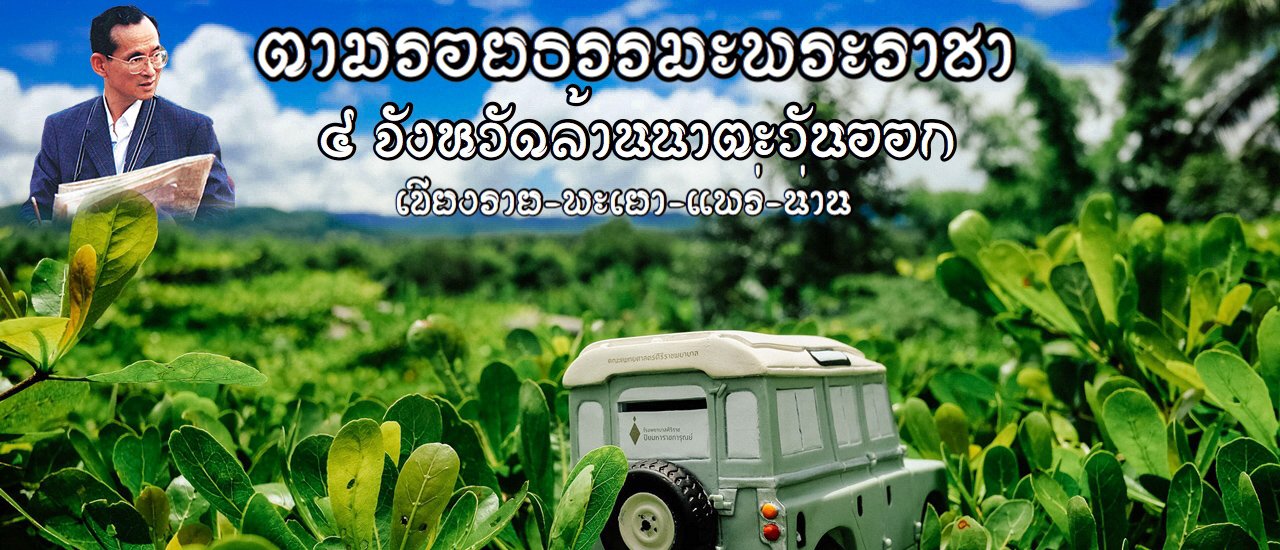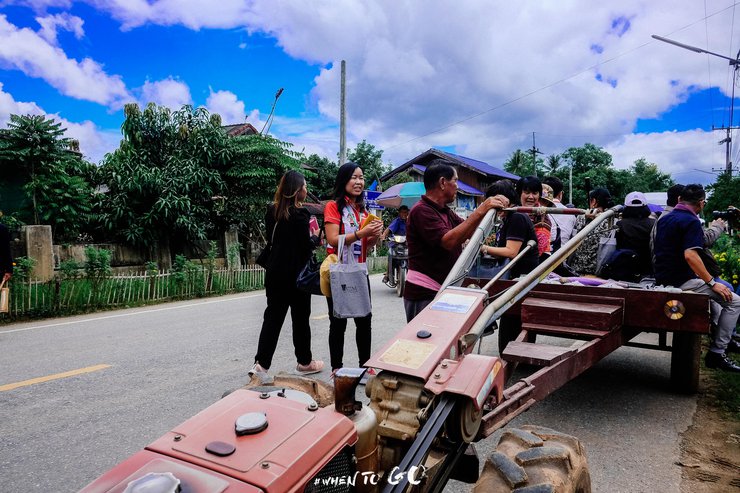The King's initiative on community development focuses on empowering rural communities to become self-sufficient. The numerous projects and activities based on this initiative, implemented across the country, have led to self-reliance, fostering community-based ecotourism. These projects also promote the dissemination of knowledge and the philosophy of sufficiency economy. Ultimately, all these initiatives aim to empower citizens to become self-sufficient, both in terms of their livelihoods and agricultural development. Today, we embark on a journey to follow the King's teachings and share the stories of His Majesty King Bhumibol Adulyadej's royal projects.

The journey began with a flight on Thai AirAsia to Mae Fah Luang Airport in Chiang Rai province. After collecting our luggage, a van was waiting to take us to Sahas, a famous pork blood soup restaurant in Chiang Rai. After a satisfying meal, we embarked on a 1.30-hour drive to our first destination of the trip.


● Ban Saew Community, Chiang Saen District, Chiang Rai Province ●
Ban Saew Subdistrict is located in Chiang Saen District and consists of 15 villages.
The community originated from people from the Northeast region who migrated and settled here for more than 60 years.
The general condition is a flat area along the Mekong River, bordering Laos. The way of life of the people in Ban Saew community involves the Mekong River.
The culture here is a blend of Isan and Lanna, including local food, clothing, and performing arts.
Ban Saew community is currently being developed as a systematic ecological tourism area, promoting tourism based on the way of life along the Mekong River.
It is suitable for everyone who wants to immerse themselves in the simple way of life of the Isan and Lanna cultures.







Activities
- Boat trip to enjoy the natural atmosphere along the Mekong River, watch the sunrise and sunset, and watch the art performances that blend Isan and Lanna cultures.
- Enjoy local food such as Jaew Bong, Banana Stem Curry, Aom Pak, and there are homestays to accommodate interested tourists.











This includes passion fruit cultivation, which has received guidance from the Royal Project, as well as the care, harvesting, and sale of produce to the Royal Project.


In addition, local products such as processed Inca berry seeds are available for purchase as souvenirs.
● Sri Don Chai Tai Lue Community, Chiang Khong District, Chiang Rai Province ●
The Sri Don Chai Tai Lue Women's Weaving Group is a collective of Tai Lue women who weave and sell fabrics to generate income for their families. They have a showroom, a hand-weaving center, and a sewing center. Their woven fabrics have gained significant attention from the public, and government agencies have placed numerous advance orders. Additionally, the Tai Lue people warmly welcome visitors with "Lae" (phonetic spelling, unsure of exact pronunciation) and refreshing butterfly pea flower juice.





















●Black Hmong Museum●
This is a place that exhibits the history of the Tai Lue people, the history of Tai Lue woven fabrics, and the various cultures of the Tai Lue people.
The Lahu way of life is showcased through performances, musical instrument playing, Lahu singing, and the spinning of Lahu cotton into intricate patterns on fabric.
● Pong Mai Community, Phuzang District, Phayao Province ●
Pong Mai Community is a community that follows the sufficiency economy philosophy of King Rama IX. This community is located approximately 90 kilometers from Phayao Province.
The community is strong with the Mother of the Land Fund, which provides welfare to the community and promotes a self-sufficient lifestyle.
Visiting this community, you will experience the natural atmosphere of the Thai-Lao border.
Activities include long drum performances, traditional hand-operated brown rice milling demonstrations, and the sale of agricultural products.







● **Fai Kwang Wittayakom School, Phayao Province** ●
This school provides educational opportunities for hill tribe children without identification cards, adhering to the educational philosophy of the King's Project.
Activities include donating school supplies and clothing to students, following the example of the King. There are also performances by students from 5 ethnicities.
The school also grows coffee and processes the beans, selling them at a coffee shop within the school.
The Tourism Marketing Association of Thailand has donated computer equipment to support the school's teaching and learning activities.







Nong Klang Village, Chiang Muan District, Phayao Province
Nong Klang Village in Chiang Muan is a community that continues the King's project to reduce burning and deforestation. Currently, they have successfully restored the community forest.
Key attractions:
- Phra That Bhu Por: A temple with over 1000 angel statues surrounding it. From the top, you can see the entire Chiang Muan district.
- Whitewater Rafting: Experience the thrill of whitewater rafting on the Luang River. The cost is 1500 baht per raft, with a maximum of 10 people. The rafting takes about 30 minutes and is best enjoyed from October onwards. Contact the Nong Klang Community Tourism for bookings.
- Chiang Muan Dinosaur Museum: Learn about the fascinating history of dinosaurs in the region.
- Local Lunch: Enjoy a delicious lunch prepared by the Nong Klang Housewives Group, featuring authentic local cuisine. You will also be welcomed with a traditional wrist-tying ceremony.
Contact:
- Nong Klang Community Tourism: Facebook Page














● Tung Hong Community, Tung Hong District, Phrae Province ●
Tung Hong Subdistrict was originally a small village. The local people were Thai Yuan people, called "Ban Tung Hong", which means
An anvil for a craftsman to use as a base for hammering iron, resulting in wear and tear or a depression or hole because almost every household had a blacksmithing profession.
Used as containers, equipment, and various utensils until it was named "Ban Tung Hong". Later, it was changed or distorted to "Tung Hong".
Visit the learning center for dyeing fabric from the Hom tree, which is considered the main occupation of the people of Tung Hong. It is the local wisdom of the ancestors.
Which has been passed down for a long time, a unique characteristic of Phrae Province, which currently, Hom-dyed fabric is very popular among both working-age groups and teenagers.







● Trai Noi Community, Den Chai District, Phrae Province ●
Meet the female village headman who will share the origin of the swing pole made from teak wood from Phrae Province. Witness the production of local products, including the processing of taro. Enjoy a local dinner featuring fresh, clean, and pesticide-free ingredients sourced from the surrounding area. The breathtaking view of green rice fields and the cool, misty air after a refreshing rain will enhance your dining experience.






● Huai Phan Community, Chiang Klang District, Nan Province ●
Huai Phan village is approximately 2 hours from Nan city center and requires a high-clearance pickup truck for access due to the alternating concrete and gravel road conditions. The journey takes an additional 20 minutes. This community prioritizes education, with a learning center and a daycare center within the village providing education for children. Surrounding the village, a stream flows into the Nan River, ensuring abundant water resources for year-round rice cultivation. However, due to the mountainous terrain, the rice paddies are terraced. We had lunch at Huai Phan village, where the local community prepared a welcoming meal. The highlight was the fish cooked in bamboo tubes, which had a delicious and aromatic flavor. After a satisfying lunch, it was time to continue our journey to the next destination.












● Bo Sawak Community, Mueang District, Nan Province ●
The Bo Sawak community is renowned for its earthenware pottery, dating back over 700 years. Generations of villagers have passed down their knowledge and skills, teaching younger generations about the history and process of pottery making, from the initial clay preparation to the final stages. The community actively engages interested youth and houses a museum showcasing earthenware, household items, and traditional houses from earlier times for educational purposes. Visitors can also savor refreshing butterfly pea and longan juice, tender coconut milk custard, and traditional Hang Lay curry served in a banana leaf cup.












● Wat Phumin, Wat Chang Kham Worawihan, and Nan National Museum ●
These three landmarks are must-visits for anyone traveling to Nan.
Wat Phumin's four-sided ordination hall features the world-famous "Whispering Mural."
Across the street, the Nan National Museum welcomes visitors with a frangipani archway, perfect for photo opportunities.
Unfortunately, due to time constraints, I was unable to visit Wat Chang Kham. However, I plan to return and explore it on a future trip.
It was time to head to Nan Nakhon Airport for my flight back to Bangkok. Farewell, Nan! I will stay longer next time.










This journey following the footsteps of the revered King in the four provinces of Eastern Lanna brought me immense joy.
This passage provides insights into the practical application of the Sufficiency Economy philosophy, offering fresh perspectives from local communities. While I possess some prior knowledge on the subject, this engagement has enriched my understanding.
Today, I gained a deeper understanding of the villagers' way of life and the legacy that our father, the King, has bestowed upon all Thai people.
If you have the opportunity, come visit. You will have one of the most valuable new experiences of your life.
Following the King's footsteps, living a self-sufficient life for true happiness.
Mr'Napat Ittiyos
Tuesday, October 8, 2024 11:31 AM















